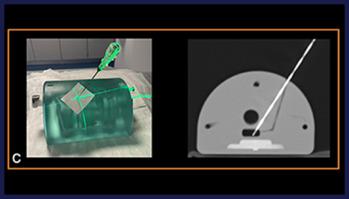Journal of Vascular and Interventional Radiology ( IF 2.6 ) Pub Date : 2022-09-24 , DOI: 10.1016/j.jvir.2022.09.014 Lena S Becker 1 , Kristina I Ringe 1 , Cornelia L A Dewald 1 , Christian Canstein 2 , Jan B Hinrichs 1 , Frank K Wacker 1 , Bernhard C Meyer 1

|
Purpose
To test the hypothesis of equal or even superior applicability and accuracy of a fully integrated, laser-based computed tomography (CT) navigation system compared with conventional CT guidance for percutaneous interventions.
Materials and Methods
CT-guided punctures were first performed in phantoms. Four radiologists with different experience levels (2 residents (L.B., C.D.) and 2 board-certified radiologists (B.M., K.R.) performed 48 punctures using both conventional image-guided and laser-guided approaches. Subsequently, 12 punctures were performed in patients during a clinical pilot trial. Phantom targets required an in-plane or a single-/double-angulated, out-of-plane approach. Planning and intervention time, control scan number, radiation exposure, and accuracy of needle placement (measured by deviation of the needle tip to the designated target) were assessed for each guidance technique and compared (Mann-Whitney U test and t test). Patient interventions were additionally analyzed for applicability in a clinical setting.
Results
The application of laser guidance software in the phantom study and in 12 human patients in a clinical setting was both technically and clinically feasible in all cases. The mean planning time (P = .009), intervention time (P = .005), control scan number (P < .001), and radiation exposure (P = .013) significantly decreased for laser-navigated punctures compared with those for conventional CT guidance and especially in punctures with out-of-plane-trajectories. The accuracy significantly increased for laser-guided interventions compared with that for conventional CT (P < .001).
Conclusions
Interventional radiologists with differing levels of experience performed faster and more accurate punctures for out-of-plane trajectories in the phantom models, using a new, fully integrated, laser-guided CT software and demonstrated excellent clinical and technical success in initial clinical experiments.
中文翻译:

基于 CT 穿刺的完全集成激光引导:模型和患者的研究
目的
测试完全集成的基于激光的计算机断层扫描 (CT) 导航系统与经皮介入的传统 CT 引导相比具有相同甚至更高的适用性和准确性的假设。
材料和方法
CT 引导的穿刺首先在模型中进行。四名经验水平不同的放射科医师(2 名住院医师(LB、CD)和 2 名经委员会认证的放射科医师(BM、KR)使用传统的图像引导和激光引导方法进行了 48 次穿刺。随后,在一个周期内对患者进行了 12 次穿刺临床试点试验。幻影目标需要平面内或单/双角度、平面外方法。计划和干预时间、控制扫描次数、辐射暴露和针放置的准确性(通过偏差测量针尖到达指定目标)针对每种引导技术进行了评估并进行了比较(Mann-Whitney U检验和t检验)。另外还分析了患者干预在临床环境中的适用性。
结果
激光制导软件在体模研究和临床环境中对 12 名人类患者的应用在所有情况下在技术和临床上都是可行的。 与激光导航穿刺相比,激光导航穿刺的平均计划时间 ( P = .009)、干预时间 ( P = .005)、对照扫描次数 ( P < .001) 和辐射暴露 ( P = .013) 显着减少常规 CT 引导,尤其是在具有平面外轨迹的穿刺中。与传统 CT 相比,激光引导干预的准确性显着提高 ( P < .001)。
结论
具有不同经验水平的介入放射科医生使用全新、完全集成的激光引导 CT 软件,对体模模型中的平面外轨迹进行了更快、更准确的穿刺,并在初始临床实验中展示了出色的临床和技术成功。











































 京公网安备 11010802027423号
京公网安备 11010802027423号